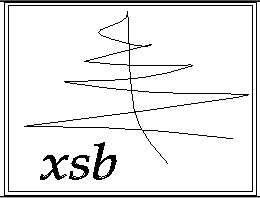

 More on XSB ...
More on XSB ...
Syntactica permits many aspects of syntactic theory to be explored. The rule and lexicon windows allow its user to assign and control the percolation of syntactic features. The TreeViewer window is used to perform a variety of formal operations on trees by simply pointing, clicking and using the Transforms panel. Syntactica also allows its user to control various constraints on operations, including an elementary version of Subjacency.
![[jacket image]](Pics/LARSP.sm.jpeg) Together with
Richard K. Larson,
David S. Warren and
Juliana Freire de Lima e Silva,
the main designers and developers of Syntactica, we co-authored
Syntactica's manual and published it under MIT Press (the not so ugly jacket
of which is depicted on the left; the original design was much worse :-).
The manual and accompanying software (for computers running NeXTStep),
is available since January 1996 in bookstores.
Together with
Richard K. Larson,
David S. Warren and
Juliana Freire de Lima e Silva,
the main designers and developers of Syntactica, we co-authored
Syntactica's manual and published it under MIT Press (the not so ugly jacket
of which is depicted on the left; the original design was much worse :-).
The manual and accompanying software (for computers running NeXTStep),
is available since January 1996 in bookstores.
A Windows 95 port of Syntactica is already available as a beta-version (see below) and an official Windows 95 version (with a manual again from MIT Press) is expected to appear in bookstores by the end of 1997.
For more information on the Syntactica manual, see the corresponding
information on the
MIT Press WWW server.
 Syntactica demo! [NeXTStep only]
Syntactica demo! [NeXTStep only]
 Syntactica Win95 Beta-Test Program!
Syntactica Win95 Beta-Test Program!
Semantica permits many aspects of semantic theory to be explored. These include a wide variety of construction types such as predicates, proper nouns, demonstratives, quantifiers, tenses, and modal adverbs. Semantic theories can be built up step by step by students, with full control of their interpretive possibilities.
![[jacket image]](Pics/LAREP.sm.jpeg) As with Syntactica, the same team of authors and O. Patricia Gomez wrote a
book on Semantica (whose jacket is depicted on the left) that is about to
be published by MIT Press. The application currently is available for
machines running NeXTSTEP. A windows version of Semantica is also expected
in the near future.
As with Syntactica, the same team of authors and O. Patricia Gomez wrote a
book on Semantica (whose jacket is depicted on the left) that is about to
be published by MIT Press. The application currently is available for
machines running NeXTSTEP. A windows version of Semantica is also expected
in the near future.
For more information on the Semactica manual, see the corresponding
information on the
MIT Press WWW server.